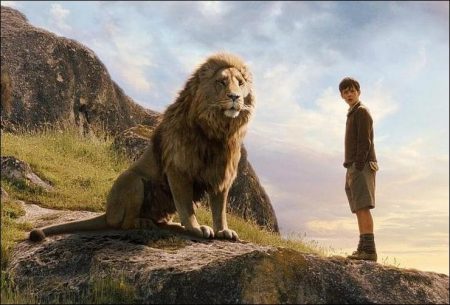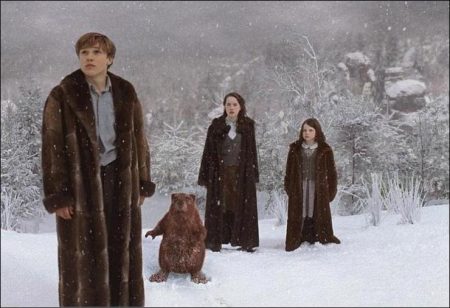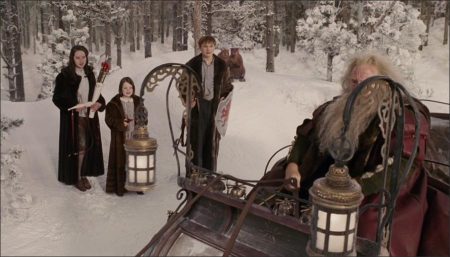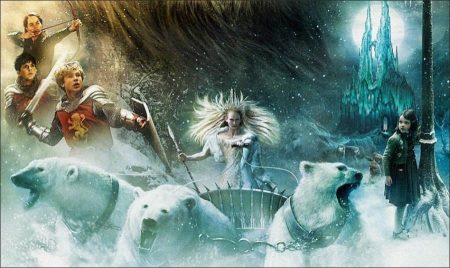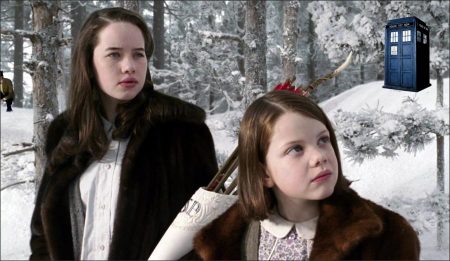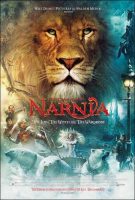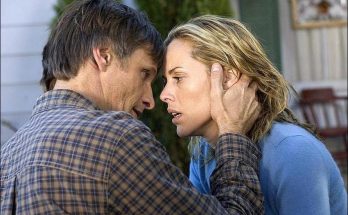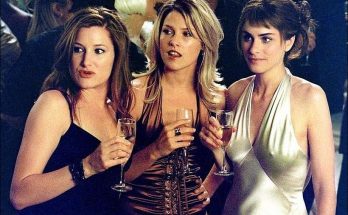An Introduction to Narnia
“The Lion, The Witch and The Wardrobe is an adventure the likes of which no one has ever been through, yet everyone who is, or ever was, a child would love to be a part of.” — Producer Mark Johnson
In 1950, the scholar, critic and writer C.S. Lewis published The Lion, The Witch and the Wardrobe, the first of his seven-volume series, The Chronicles of Narnia, and established a modern legend. A long-time fan of what he called “fairy stories,” Lewis had set out to write a series of fantasy tales for children, but his creation turned out to be much larger and grander than even he had foreseen.
Adults and children alike fell in love with his stirring, action-packed adventure that was set in the middle of World War II bombing raids yet transported readers into an alternate and far more enchanted universe of mythological creatures waging an epic battle between good and evil. Meanwhile, critics were impressed with Lewis’ rare ability to forge a completely believable, imaginary world – one with its own history, geography, culture and myths that nevertheless reflected the struggles.
Profoundly affecting its fans, The Lion, The Witch and The Wardrobe went on to develop an enduring, worldwide readership and to become a staple of family libraries across the planet. The entire Chronicles of Narnia series – which also includes Prince Caspian, The Voyage of the Dawn Treader, The Silver Chair, The Horse and His Boy, The Magician’s Nephew and The Last Battle — took the publishing world by storm, eventually selling over 85,000,000 books in 29 different languages, making it second only to J.K. Rowling’s Harry Potter tomes as the most popular book series ever. Indeed, Rowling has cited C.S. Lewis’s Narnia as one of the inspirations to her own contemporary stories of magic and adventure.
From the beginning, C.S. Lewis had wanted the experience of Narnia’s wonders to be open to people of all background and ages. Explains the film’s co-producer, Lewis’ stepson Douglas Gresham, who grew up knowing Lewis and his writing intimately: “C.S. Lewis’ mandate, his main idea about writing for children, included the theory that if a book is worth reading when you’re five, it is still equally worth reading when you’re fifty. So The Chronicles of Narnia was intended to be read to children and by children and also to be read by adults with great joy even to the last days of their lives.”
Along with a few other rare stories such as The Lord of the Rings (written by Lewis’ close friend and contemporary J.R.R. Tolkien), The Lion, The Witch and The Wardrobe became the equivalent of a foundational 20th century fable. It was one of those timeless adventures that equally fascinated grade-schoolers, grown-up readers and the most sophisticated literary scholars intrigued by its metaphors and spiritual allegories.It soon saw many incarnations in stage versions, as a British television series, as an animated film and even in a BBC version created almost entirely with puppets.
But no one dared to attempt to bring Lewis’ land of Narnia to life with real actors and sets, perhaps because it simply seemed too vast and overwhelming an undertaking. Only recently, as technology has at last begun to catch up with Lewis’ far-reaching imagination was it even possible to imagine re-creating Narnia with the thrilling realism director Andrew Adamson brings to the story.
C.S. Lewis’ stepson, Douglas Gresham — the creative and artistic director of Lewis’ estate and the C.S. Lewis Company — always believed a motion picture of Lewis’ masterwork would one day become reality. He stuck by the dream of bringing the story to life in a way that would honor Lewis’ enduring creation for decades. “I’ve been working on seeing a movie made of The Lion, the Witch and the Wardrobe, one way or another, for probably twenty-five or thirty years,” Gresham notes. It was not until Gresham was approached by Walden Media that the project truly began to take shape. “The Lion, The Witch and the Wardrobe was my very favorite book as a kid, like it was for so many other people,” notes executive producer Perry Moore, who was then a film executive at Walden Media. “I always thought it was the perfect fit for Walden.”
From the start, everyone at Walden and subsequently at Disney was committed to remaining steadfastly true to the spirit of C.S. Lewis’ story — without adding manufactured twists to a story that has continued to inspire generation after generation. “On the very first day that we sat down with the estate, we assured them that we were going to do an absolutely faithful adaptation,” Cary Granat of Walden Media explains. “Perry and I and, most importantly, Phil Anschutz [Walden Media’s founder], were devoted to that vision. We weren’t looking to put modern-day spin on this piece, but to honor it as a classic of all times.”
Sums up Gresham, for whom the journey to bringing his stepfather’s work to the screen was profoundly personal: “The story of The Lion, The Witch and The Wardrobe is so true, so honest, so straightforward, we felt certain that the less we messed around with it, the better movie we would make. The first and most important thing about getting this movie made properly was to get the right people involved. Finding Andrew Adamson and bringing him on as director was key.”
Behind Narnia’s Magic: The Special Visual Effects
“We had gigantic challenges along the way. The battle alone was made up of thousands and thousands of creatures, which includes polar bears, lions, tigers, centaurs, ogres, boggles, etcetera. Just an incredible undertaking.” — Producer Mark Johnson
The creation of Narnia would ultimately require more than just creative power – it also required massive computing power, combining the efforts of the some of the hottest and most innovative effects houses in the world to digitally enhance the otherworldly characters and landscapes of this alternate universe.
“This is a story filled with incredible creatures,” remarks Adamson. “To give a sense of the scope, in the final battle, there are 20,000 creatures. All these creatures were created at least partly in a computer but no singular approach was used. Some creatures are CG all of the time. Some creatures are half computer generated and half live-action. A centaur, for instance, might have a human upper body with a computer generated horse lower body, while the beavers were entirely computer generated. The idea was to have it all meld together into one cohesive universe that feels entirely real.”
“The Lion, The Witch and The Wardrobe is one of the biggest special effects movies ever made,” adds producer Mark Johnson, “and to pull it off we used three of the biggest, most creative effects companies in the world — Rhythm & Hues, Sony Pictures Imageworks and ILM – simultaneously.”
In the beginning, the filmmakers asked several effects companies to “audition” for the various characters, almost like actors. Johnson explains: “We would take a single character, let’s say Mr. Beaver, and ask five separate companies to take a stab at animating this character. There were no guidelines. We said `let’s see what you can do to demonstrate what Mr. Beaver would look like.’ That’s how we chose the best houses for the job.”
Overseeing the work was VFX Supervisor Dean Wright, a veteran of the second and third “Lord of the Rings” films. Wright collaborated with Rhythm & Hues Bill Westenhofer, Sony’s Jim Berney and ILM’s Scott Farrar to create somewhere between 1,000 and 1,400 CGI shots and images for the film. According to director Adamson, “there really isn’t one frame, one scene, that is not touched by a visual effect.” Eventually, some 1,000 people would work on the effects and some 50 terabytes of information for the film would be stored at three different effects houses. Large libraries of newly created images were shared back and forth by each of the houses as they worked in concert with one another, layering scenes with richer and richer effects.
So while Sony Pictures Imageworks was creating the CGI beaver performances and forging CGI wolves so photo-realistic they were able to mix seamlessly in with a pack of real animals in certain sequences, Rhythm & Hues was honing Aslan’s magnificent musculature and ILM was tinkering with how centaurs might walk. Then, the teams might switch, each working on a different aspect of Narnia’s massive world. “In every element, the aim was always to have each the creatures be entirely believable right next to our human cast,” sums up Wright.
Ultimately, all the film’s elements – from locations and designs to practical effects and digital wizardry would come together in the most challenging sequence of all: the climactic battle for Narnia as Aslan’s army takes on the forces of the White Witch. Andrew Adamson had envisioned a spectacular scene involving some 20,000 characters on screen at once – one that sprung primarily from his imagination. “In the book, the battle is one about a page and half long. Lewis writes about it in very simple, `you should have been there’ terms, but in my imagination was always this incredible battle with minotaurs against centaurs against fauns and satyrs. We had to show the battle, an incredible battle like nothing that has ever been done before,” says the director.
The sequence was shot at New Zealand’s Flock Hill Station, on a rugged plateau featuring snow-capped vistas. There, the film’s cast and hundreds of extras dressed in the otherworldly creations of WETA and K.N.B., played out the war for Narnia’s future. Later, Rhythm & Hues employed the same groundbreaking software used to create the spectacular battles in “Lord of the Rings’ – the artificial intelligence program known as Massive – to multiply the fighters into the tens of thousands and to control each fighter’s individual moves and motions. “We have 20-30 creatures on screen at any one time and they each have their own unique attributes in terms of how they jump, run, walk, move and fight,” observes Dean Wright. “It’s an enormous challenge to make this look believable, but with the computer simulations, you have the tools you need to make it look as good as it possibly can.”
When the battle was completed, Andrew Adamson knew his Narnia had truly made the journey from a fantastical vision in a child’s fevered imagination to the motion picture screen. “Making this film was a daunting exercise in every way,” sums up Adamson. “It was very technically daunting in terms of effects and digital creations and daunting from a filmmaking perspective in terms of scope and design. It was daunting to work with four children as the main characters. But, I think the most daunting thing of all for me was simply the responsibility I felt to this beloved story. It’s a huge thing to try to live up to what millions of people have imagined and dreamed about Narnia over 3 or 4 generations but that is what we set out to do.”
The Chronicles of Narnia: The Lion, The Witch and the Wardrobe (2005)
Directed by: Andrew Adamson
Starring: Georgie Henley, Skandar Keynes, Anna Popplewell, William Moseley, Jim Broadbent, Tilda Swinton, Rupert Everett, Elizabeth Hawthorne, Judy McIntosh, Shane Rangi
Screenplay by: Ann Peacock
Production Design by: Roger Ford
Cinematography by: Donald McAlpine
Film Editing by: Sim Evan-Jones, Jim May
Costume Design by: Isis Mussenden
Set Decoration by: Kerrie Brown, Amy Wright
Art Direction by: Jules Cook, Ian Gracie, Karen Murphy, Jeffrey Thorp
Music by: Harry Gregson-Williams
MPAA Rating: PG for battle sequences, frightening moments.
Oistributed by: Buena Vista Picturs
Release: December 9, 2005
Visits: 81
